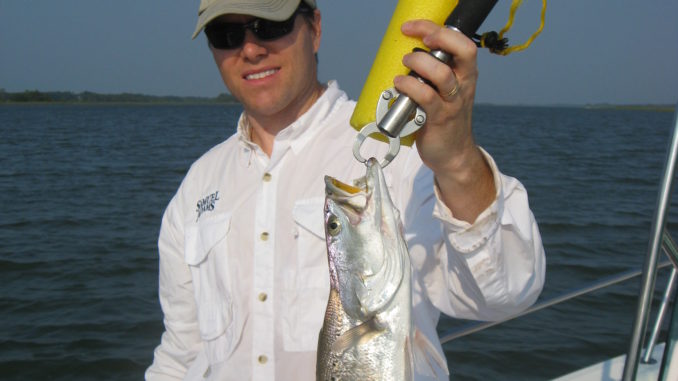
Cape Romain guide goes light, light light for winter specks
If you’re a fisherman who can tolerate cold weather, now is the time to get on the water, with solid action on speckled trout reported from up and down the South Carolina coast. But with cold weather comes crystal-clear water, so sleek terminal tackle and flawless connections are required for the conditions.
Even though fish may want to eat like a piranha this time of year, the cold water restricts their movements, and their feeding activity meter is barely registering. In order for an angler to get a rise, a finesse-type tactic must be used. For Tom Siwarski of Carolina Aero Marine Adventures, a small jig on light line is his choice when targeting specks along the Intracoastal Waterway near Cape Romain and Bulls Bay.
“I use very thin, braided line during the winter,” said Siwarski (843-327-3434). “I use small jigs to catch trout in the deep holes, and the 10-pound braid is crucial for its sensitivity and ability to cut through the water column quickly.”
Ten-pound braid has the same diameter as 3-pound monofilament. Speckled trout have a very light bite, especially during the winter when the water is cold, and the super- sensitive braid line allows Siwarski to get his light lures down to the fish while maintaining a tight connection.
“Braided line is more sensitive, and the biggest advantage to feeling the subtle winter speck bite,” he said.
Since the water is gin clear, Siwarski will use a 3-foot section of fluorocarbon leader between his main line and his jig or artificial shrimp. The fish have plenty of time to evaluate the lure and fluorocarbon’s invisibility is often the difference between catching fish and dangling a lure in the water. Unlike monofilament, light goes through fluorocarbon because the refractive index is identical, and fluorocarbon has the same stretch qualities of braid, giving Siwarski additional sensitivity.
Fluorocarbon leader, Siwarski said, is “absolutely necessary this time of year for catching trout in clear water.”
In addition, Siwarski is constantly checking his leader for any nicks or imperfections that might cause him to miss or lose a fish, especially in the kind of water he’s fishing.
“Oysters and other underwater structures will compromise the leader’s strength quickly,” he said. “I will not think twice about cutting off the end section or re-tying a brand new leader segment to make sure I don’t lose a fish. The bites can be numbered this time of year, and I am not going to risk losing a fish from a bad spot on the leader.”




Be the first to comment